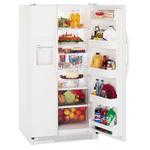Search engine visitors - click here to access entire "$ensible Home" web site
Click here to see a descriptive illustration showing illustration of two types of efficient refrigerator/freezers and features.
Related links - DIY Appliance Maintenance Guides
Dear Jim: We are remodeling our kitchen and we should replace our old refrigerator/freezer. I know newer ones are more efficient. What are the most efficient models and what new convenience features are best? - Ann T.

A: Other than space and water heating and cooling, the refrigerator/freezer is the largest electricity consumer in most homes. Replacing a large older one with a new efficient model may save up to $100 annually on your electric bills. This can pay back its cost fairly quickly.
Another key advantage of replacing an older model is that the new ones have much better temperature controls and even temperatures throughout the unit. This keeps foods fresher for a longer time for your family's health.
The first buying decision is the size of refrigerator/freezer to buy. All other things being equal, a larger size uses more electricity than a smaller one. A rule of thumb is a family of two needs 10 cubic feet of refrigerator space. Add another one to two cubic feet for each additional family member.
Even the most efficient ones now have attractive exteriors becasue of material and manufacturing improvements. There are some very attractive antique (1897-style) models with painted curved doors and nickel-plated trim. Others use easy-to-clean, professional-looking stainless steel.
Most refrigerator/freezers use a single compressor with dual controls for the two compartments. Some very efficient models include two separate compressors, one for the refrigerator and one for the freezer, for the best temperature control. Others use one variable-speed compressor for precise control.
Although side-by-side refrigerator/freezers use somewhat more electricity than an over/under style, they offer the most capacity and convenience. Some models have a unique staggered shape with the refrigerator portion wider at the top and the freezer section wider at the bottom.
Another new feature is a special drawer with its own temperature controls. It is designed to either freeze foods quickly or to thaw them in half the normal time, depending on the mode you select. Other models have super-quick ice maker compartments to make ice cubes in one hour or less.
For convenience, one efficient model is circular. The glass shelves inside rotate similar to a lazy Susan, so it is easy to access any food items. Other models are designed to run on 12-volts to be powered by batteries, windmills, solar panels, etc. Another built-in model has a remote compressor that can be located up to 15 feet away from the unit.
Some other convenience features to consider are crank-up elevator-type or folding shelves, built-in water filters and multi-level interior lighting.
Instant Download Update Bulletin No. 437 - buyer's guide of the 13 most efficient, full-featured refrigerators, freezer locations, sizes, colors available, features such as through-the-door ice/water dispenser, insulating packages, sprillproof shelves, illustrations, tips for lowering your refrigerator energy usage, efficiency recommendation chart, tips for buying a new refrigerator, explanation of the Energy Guide label and several prices.
Dear Jim: I just moved into an existing house and the dryer vent from the laundry ends in the basement, not outdoors. The lint is getting to be a messy problem. What can I do to take care of this problem? - Sheila H.
A: This is really not an uncommon problem in homes, but it can be a very dangerous one. Dryer lint is very easily ignited and there are many house fires each year because of lint buildup from clothes dryers.
If there is a multipane window in the basement, remove one of the panes and replace it with a sheet of aluminum. Cut a hole in it and run the dryer vent through it. Make sure to install a tight-sealing vent cover.